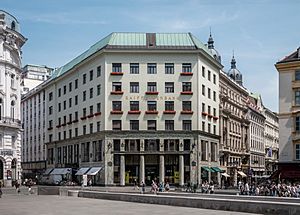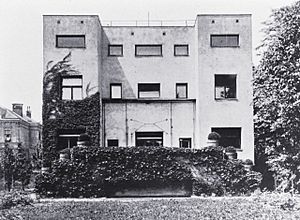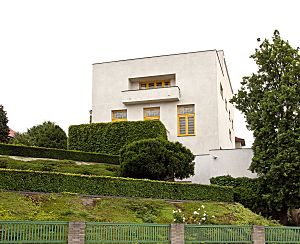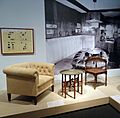Adolf Loos facts for kids
Quick facts for kids
Adolf Loos
|
|
|---|---|

Loos c. 1904
|
|
| Born |
Adolf Franz Karl Viktor Maria Loos
10 December 1870 |
| Died | 23 August 1933 (aged 62) |
| Nationality | Austria, Austria-Hungary |
| Occupation | Architect |
| Buildings | Looshaus, Vienna Villa Müller, Prague |
Adolf Loos (born December 10, 1870 – died August 23, 1933) was an important architect from Austria and Czechoslovakia. He was a thinker and writer who had a big impact on modern architecture in Europe.
Loos was inspired by modern ideas and was a well-known critic of the Art Nouveau style, which used lots of fancy decorations. His strong ideas and writings helped start the Vienna Secession movement, which favored simpler designs. He also influenced later styles like postmodernism.
Adolf Loos was born in Brno into a family of artists who worked with stone. His father, a stonemason, died when Adolf was nine. This sparked Loos's interest in arts and crafts. Loos had hearing problems, which made him a bit quiet.
He went to many different colleges, which gave him a wide range of skills for architecture. After finishing his studies, Loos visited America. He was very impressed by the Chicago School of Architecture. He especially liked the architect Louis Sullivan and his idea that "form follows function". This means a building's shape should come from its purpose.
Loos wrote many important pieces. One famous work was Ornament and Crime. In this essay, he argued for simple, smooth surfaces instead of the fancy decorations popular at the time. His ideas led to the modern look of buildings like the Looshaus in Vienna.
Loos became a leader in modern architecture. He created the "Raumplan" (meaning spatial plan). This was a special way of arranging rooms inside a building, making them different heights and sizes based on how they would be used. The Villa Müller in Prague is a great example of this. He passed away at age 62 in Kalksburg, near Vienna.
Contents
Early Life
Youth and Family
Adolf Loos was born on December 10, 1870, in Brno. This area was part of the Austro-Hungarian Empire, and is now in the eastern Czech Republic. His father, also named Adolf Loos, was a German stonemason. He died when young Adolf was only nine years old.
His mother, Marie Loos, was a sculptor. After her husband's death, she continued to run the stonemason business. Young Adolf Loos had inherited his father's hearing problems. This made it hard for him to hear throughout his life.
Education and Skills
Loos went to several different schools and tried many study programs. In 1884, he started at the Stiftsgymnasium Melk but only stayed a few months. He then studied mechanics at a technical college in Liberec. Later, he switched to building technology.
He returned to mechanics in 1889 and then studied architecture at Dresden University of Technology from 1890 to 1893. Loos never got a university degree. However, his varied education gave him many useful skills. For example, he understood how stonework and crafts affected architecture. Because of his experience, many experts in architecture respected him.
Career
Time in the United States
After college, Loos traveled to the United States from 1893 to 1896. He wanted to experience life there and learn about American architecture. He started in New York and supported himself by taking jobs like a mason and a dishwasher.
These jobs allowed Loos to move to the countryside near Philadelphia. There, he worked as a watchmaker with his uncle. He admired America's rural culture. Later, he went to New York and Chicago to see American buildings.
In Chicago, Loos was very impressed by the new American skyscrapers and the World's Columbian Exposition in 1893. He especially liked the architect Louis Sullivan and the Chicago School of Architecture. He agreed with Sullivan's idea that a building's "form follows function" – meaning its design should be based on its purpose.
Even though Loos left America in 1896, he stayed connected to Chicago. In 1922, he entered a competition to design the Chicago Tribune Tower. His design looked like a giant Doric column at the top. He didn't win, but his idea inspired later architectural styles like postmodernism.
Return to Vienna
Loos came back to Vienna in 1896 and made it his home. He became a well-known person in the city. He was friends with famous people like Ludwig Wittgenstein, Arnold Schönberg, and Karl Kraus.
Inspired by his years in America, he focused on architecture. For a short time in 1896, he was part of the Vienna Secession movement. But he soon disagreed with their style. He believed in a new, simple, and plain architecture without extra decorations. He also thought about how to use the entire floor plan in a useful way. Loos's first projects were designing the insides of shops and cafés in Vienna.
Ideas on Architecture
Loos wrote many strong essays about his ideas. In a book called Spoken into the Void, published in 1900, he criticized the Vienna Secession movement.
His most famous essay is Ornament and Crime, which he first presented as a lecture in 1910. In this work, he argued that as cultures progress, they use less decoration on everyday objects. He famously said that "the evolution of culture is synonymous with the removal of ornamentation from objects of everyday use." He believed it was wrong to make builders waste time on decorations that would quickly make an object look old-fashioned.
Loos's simple buildings, without much decoration on the outside, influenced modern architecture. While the outsides were plain, the insides of many of his buildings used rich and expensive materials. He used beautiful stone, marble, and wood, showing their natural patterns. He believed in "organic" decoration, like patterns found in nature or made by native cultures, rather than unnecessary, fancy additions.
Loos also liked decorative arts. He collected high-quality silver and leather goods, valuing their simple but luxurious look. His glassware, made by Lobmeyer, is still made today. He also enjoyed fashion and designed clothing for the famous Kníže store in Vienna.
Famous Buildings
From 1904, Loos started working on bigger projects. His most famous was the "Looshaus", built from 1910 to 1912. It was originally for a tailor shop in Vienna. This building is right across from the Hofburg Palace, where the Habsburg emperors lived.
The Looshaus, located at Michaelerplatz 3, Vienna, is now a protected historical building. When it was built, people criticized it. Its simple, straight window patterns and lack of stucco decoration earned it the nickname "House without Eyebrows". Emperor Franz Joseph I of Austria reportedly disliked the modern building so much that he avoided leaving the Hofburg Palace through the main gate nearby.
Other important works by Loos include the men's fashion store Knize (1909–13), Café Museum (1899), and the "American Bar" (1907–08) in Vienna.
In 1904, Loos visited the Greek island of Skyros. He was inspired by the simple, cube-shaped architecture he saw there. After World War I, when the Austro-Hungarian Empire ended, Loos became a citizen of Czechoslovakia. However, he continued to live mainly in Vienna.
During the time of the First Austrian Republic, Loos became interested in public projects. He designed several housing projects for the City of Vienna. From 1924 to 1928, Loos lived in Paris. He taught at the Sorbonne university and designed a house for Tristan Tzara, a founder of Dadaism. In 1928, he returned to Vienna.
Loos admired classical architecture. This can be seen in his writings and his entry for the 1922 Chicago Tribune competition, which was a huge Doric column.
Private Life
Marriages
Loos was married three times. In 1902, he married Lina Loos, a drama student. They divorced three years later in 1905. In 1919, when he was 49, he married Elsie Altmann, a 20-year-old dancer. They divorced in 1926. In 1929, he married Claire Beck, a writer and photographer who was 35 years younger than him. They divorced in 1932. After their divorce, Claire Loos wrote a book about Adolf Loos, sharing stories about his personality and habits.
Health
Throughout his life, Loos had hearing problems. As a child, he was deaf and only gained some hearing at age 12. In 1918, he was diagnosed with cancer and had surgery. By the time he was 50, he was almost completely deaf.
Death and Legacy
Adolf Loos showed signs of memory problems before he died. A few months before his death, he had a stroke. He passed away at age 62 on August 23, 1933, in Kalksburg near Vienna. Loos was buried in Vienna's Zentralfriedhof among other great artists and musicians, including some of his close friends.
Through his writings and important buildings in Vienna, Loos influenced many other architects and designers. He played a key role in the early development of Modernism. His careful choice of materials, his love for good craftsmanship, and his "Raumplan" method (designing interior spaces based on their use) are still admired today.
Major Works
- 1899 Café Museum, Vienna
- 1904 Villa Karma, Montreux, Switzerland
- 1908 American Bar (formerly the Kärntner Bar), Vienna
- 1910 Steiner House, Vienna
- 1910 Goldman & Salatsch Building, Vienna (also known as the "Looshaus")
- 1913 Scheu House, Vienna
- 1922 Rufer House, Vienna
- 1925 Maison Tzara, house and studio, Montmartre, Paris
- 1926 Villa Moller, Vienna
- 1928 Villa Müller, Prague, Czech Republic
- 1929 Khuner Villa, Kreuzberg, Austria
- 1932 Villa Winternitz, Praha 5, Czech Republic
- 1928–1933 Many home interiors in Plzeň, Czech Republic
Exhibitions
- Adolf Loos - Exposition Du Cinquantenaire (February 23 – April 16, 1983) Paris
- Gründerzeit: Adolf Loos (April 11 – June 21, 1987) Karlsruhe, Germany
- ADOLF LOOS (December 2, 1989 – February 25, 1990) Vienna (at Albertina, Historical Museum of the City of Vienna, Looshaus)
- Adolf Loos „Private Spaces“ (December 14, 2017 – February 25, 2018) Barcelona, Spain
- Adolf Loos „Private Spaces“ (March 28 – June 24, 2018) Madrid, Spain
- WAGNER, HOFFMANN, LOOS AND THE FURNITURE DESIGN OF VIENNESE MODERNISM (March 21 – October 7, 2018) Imperial Furniture Collection, Vienna
- Adolf Loos: Private Houses (December 8, 2020 – March 14, 2021) MAK Museum of Applied Arts, Vienna
- „Loos2021“ (September 25, 2020 – May 30, 2021) Loos Rooms at the Vienna Library
Images for kids
See Also
 In Spanish: Adolf Loos para niños
In Spanish: Adolf Loos para niños













